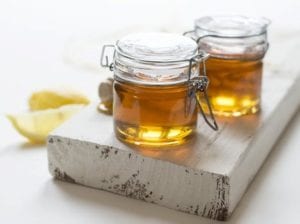Written by Greg Arnold, DC, CSCS. Study participants who applied a topical cream consisting of medical grade kanuka honey saw significant improvement in rosacea symptoms.
 Rosacea is a skin condition that affects about 14 million Americans and is common in women, those with fair skin, and between the ages of 30 and 60. Characterized by frequent flushing of the face, inflamed eyes/eyelids, and constant redness and bumps on the skin, rosacea can significantly affect a person’s quality of life (1).
Rosacea is a skin condition that affects about 14 million Americans and is common in women, those with fair skin, and between the ages of 30 and 60. Characterized by frequent flushing of the face, inflamed eyes/eyelids, and constant redness and bumps on the skin, rosacea can significantly affect a person’s quality of life (1).
Because there is no known cure, treatments are marginally effective and include topical/oral antibiotics but whose side effects make them minimally appealing (2, 3, 4). Fortunately, a natural approach to rosacea that may be effective is honey.
In a 2015 study (5), researchers studied 138 adults (70 men, 68 women) aged 42 to 70 with rosacea, which was diagnosed by having a score > 2 on the 7-point Investigator Global Assessment of Rosacea Severity Scale (6), with “0” being “clear” and “6” being “severe” rosacea. Sixty-one subjects were assigned to receive a topical cream consisting of medical grade kanuka honey in 10% glycerine (called “Honevo”) while 54 subjects received or a control cream containing a liquid paraffin and white soft paraffin topical emollient used in previous research (7).
The subjects were instructed to apply an appropriate amount of cream to the affected area twice daily for 30 to 60 minutes at a time for 8 weeks and not to use any additional treatment for their rosacea.
After 8 weeks, the following results were observed between the two groups, with 39% (24/61 subjects) of those in the honey group experiencing an improvement in their rosacea symptoms by at least 2 points on the 7-point scale compared to 23.5% (12/51) in the placebo group (p < 0.001):
| Change from Start of Study | Honey cream | Placebo |
|---|---|---|
| -3 | 11 (18% of subjects) | 1 (1.9%) |
| -2 | 13 (21.3%) | 11 (20.4%) |
| -1 | 20 (32.8%) | 17 (31.5%) |
| 0 | 14 (23.0%) | 15 (27.8%) |
| 1 | 3 (4.9%) | 8 (14.8%) |
| 2 | 0 (0%) | 2 (3.7%) |
When suggesting how kanuka honey elicits these benefits to skin health, the researchers cited honey’s anti-bacterial and anti-inflammatory properties (8, 9, 10, 11, 12).
The researchers went on to conclude that “Honevo can be recommended for the treatment of rosacea” though they recommend “further randomized controlled trials comparing Honevo with topical metronidazole and azelaic acid to determine its relative efficacy and side effect profile compared to these agents.”
Source: Braithwaite, Irene, Anna Hunt, Judith Riley, James Fingleton, Janwillem Kocks, Andrew Corin, Colin Helm et al. “Randomised controlled trial of topical kanuka honey for the treatment of rosacea.” BMJ open 5, no. 6 (2015): e007651.
This is an Open Access article distributed in accordance with the Creative Commons Attribution Non Commercial (CC BY-NC 4.0) license, which permits others to distribute, remix, adapt, build upon this work non-commercially, and license their derivative works on different terms, provided the original work is properly cited and the use is non-commercial. See: http://creativecommons.org/licenses/by-nc/4.0/http://dx.doi.org/10.1136/bmjopen-2015-007651
Click here to read the full text study.
Greg Arnold is a Chiropractic Physician practicing in Hauppauge, NY. You can contact Dr. Arnold directly by emailing him at PitchingDoc@msn.com or visiting his website at www.PitchingDoc.com.
References:
- “What Is Rosacea? Fast Facts: An Easy-to-Read Series of Publications for the Public” posted on the NIH website
- Powell FC. Clinical practice. Rosacea. N Engl J Med 2005;352:793–803
- van Zuuren EJ, Kramer S, Carter B, et al. Interventions for rosacea. Cochrane Database Syst Rev 2011;(3):CD003262.
- Elewski BE. Rosacea trial comparing twice-daily azelaic acid gel 15% with once-daily metronidazole gel 1%. Cutis 2007;79:57–8; author reply
- Braithwaite I. Randomised controlled trial of topical kanuka honey for the treatment of rosacea. BMJ Open 2015 Jun 24;5(6):e007651. doi: 10.1136/bmjopen-2015-007651
- Elewski BE, Fleischer AB Jr, Pariser DM. A comparison of 15% azelaic acid gel and 0.75% metronidazole gel in the topical treatment of papulopustular rosacea: results of a randomized trial. Arch Dermatol 2003;139:1444–50
- Van der Linden MM, van Rappard DC, Daams JG, et al. Health-related quality of life in patients with cutaneous rosacea: a systematic review. Acta Derm Venereol 2015;95:395–400
- Wu Q. Antimicrobial effect of Manuka honey and Kanuka honey alone and in combination with the bioactives against the growth of Propionibacterium acnes ATCC 6919: a thesis submitted in partial fulfilment of the requirements for the degree Master of Food Technology. Albany, New Zealand, Massey University, 2011
- Lu J, Carter DA, Turnbull L, et al. The effect of New Zealand kanuka, manuka and clover honeys on bacterial growth dynamics and cellular morphology varies according to the species. PLoS ONE 2013;8:e55898
- Leong AG, Herst PM, Harper JL. Indigenous New Zealand honeys exhibit multiple anti-inflammatory activities. Innate Immun 2012;18:459–66
- Allen KL, Molan PC, Reid GM. A survey of the antibacterial activity of some New Zealand honeys. J Pharm Pharmacol 1991;43:817–22
- Gannabathula S, Skinner MA, Rosendale D, et al. Arabinogalactan proteins contribute to the immunostimulatory properties of New Zealand honeys. Immunopharmacol Immunotoxicol 2012;34:598–607.
